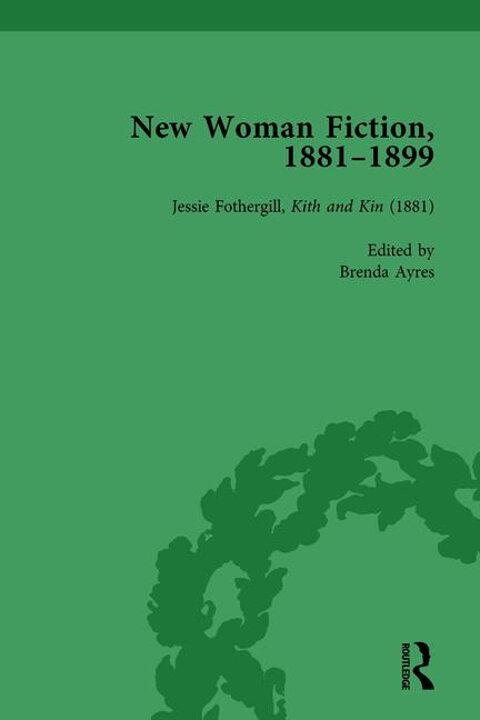Access to the full content is only available to members of institutions that have purchased access. If you belong to such an institution, please log in or find out more about how to order.
Loading content
We were unable to load the content

New Woman Fiction, 1881–1899, Part I
- Edited by
- Carolyn W. de la L. Oulton
- Published: 1 Jun 2010
- DOI: 10.4324/9781851966417
- Set ISBN: 9781851966417
The late nineteenth century saw the emergence of New Woman fiction, a genre of writing which sought to challenge traditional Victorian conceptions of the role of women and promote their independence, education and political participation. This collection brings together important examples of New Woman fiction, each of which helped to crystallise the idea of the New Woman – as an educated, politically aware and independent individual - during the early years of the suffragette movement. The book will be of interest to students of the suffragette movement, as well as to those interested in the history of feminism more generally.
Set Contents
She at last arrived almost at the top of the steep ascent. Here the view on either side was interrupted by high crags of grey limestone rock, rent and torn and tossed, while the herbage could scarce find a place amidst the chaos of huge stones and boulders which lay up and down, like the balls with which giants or demons had been playing some Titanic game. (below, p. 288)
From Jessie Fothergill’s 1881 novel, Kith and Kin, the quote above describes the ascent of one Judith Conisbrough, New Woman extraordinaire. She is surmounting the apex of her journey, even if she is unaware of it, and will become even less so before she becomes totally conscious of having achieved not only a lifetime victory for herself, but a historical victory for womankind, possible only because she is a heroine in a New Woman novel, the torrent of fiction between 1880 and 1920 that challenged Victorian constrictions of womanhood. Fothergill’s narrative is ‘subversive discourse’, as Rita Kranidis called it, ‘used by feminists as a medium through which to engage their readers’ sympathies and to sway popular opinion through gender relations’. And this is exactly what Fothergill’s heroine accomplishes; she proves that woman can be complete without a man, but she must fight for the same measure of independence, freedom and rights granted to men if she is to survive in a world still governed by them.
The labelling of Miss Brown as a New Woman novel is a recent phenomenon. When the field of New Woman studies emerged in the early 1990s, Miss Brown was not considered a relevant text. Indeed, in Ann Ardis’s classic study New Women, New Novels (1990), Miss Brown is absent from the bibliography. Some hope emerged for its inclusion when Elaine Showalter mentioned Miss Brown when discussing Vernon Lee in the introduction to Daughters of Decadence: Women Writers of the Fin-de-Siècle (1993), a collection of short stories by New Women writers; but Showalter calls it ‘a satire of the aesthetic movement’ and not a New Woman novel. It was not until years later in Christa Zorn’s Vernon Lee: Aesthetics, History, and the Victorian Female Intellectual (2003) that a link between Lee’s novel and New Woman writing was made. There were likely two main reasons behind this lengthy delay. First, unlike most New Woman novels, Miss Brown had already been studied at length and categorized, so there was a place for it in traditional scholarship. Ever since the appearance of the September 1970 issue of Colby Library Quarterly – an issue devoted entirely to Lee, with an essay specifically on Miss Brown – the novel has been subjected to numerous examinations by scholars, with the conclusion that it is only a satire of aestheticism. The second reason has to do with Lee’s tenuous status as a New Woman, making it difficult for New Woman scholars to accept all of her works. Unlike Mona Caird and Sarah Grand, Lee was not aggressively feminist. As Patricia Pulham has remarked, ‘one may seek in vain for Lee’s name in most of the New Woman debates of the fin de siècle’.
In 1888, Mona Caird was probably the most famous feminist in Britain. Her notoriety came from her publication of an article entitled ‘Marriage’ in the Westminster Review in August 1888. In response to her assertion that ‘the present form of marriage … is a vexatious failure’, the Daily Telegraph posed the question ‘Is Marriage a Failure?’ and the ensuing correspondence was huge; some 27,000 letters were received between 9 August and 29 September from men and women of all classes and occupations. The anonymized signatures indicate the range of opinions expressed: ‘One Who Has Suffered’; ‘A Contented Young Spinster’; ‘Married and Contented’; ‘A Matrimonial Failure’; ‘A Happy Husband and Father’. Although few of the letter-writers agreed to the full extent with Caird’s radical opinions, many expressed unhappiness with their married lives and it is significant that so many people considered marriage to be in question at all.